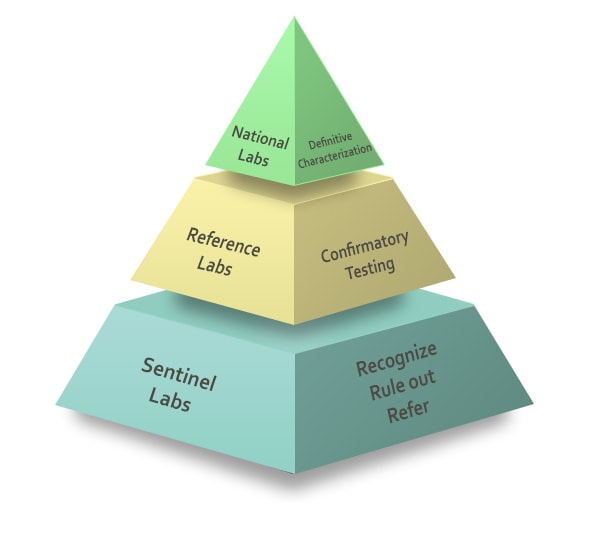Confirming Anthrax Through the Laboratory Response Network (LRN)
Anthrax is confirmed through laboratory testing at labs in the Laboratory Response Network (LRN).
Labs that test anthrax specimens
Once specimens are taken from a person, they are sent to a lab for testing. Each lab in the LRN has a different role in the testing of the specimen:

- Sentinel labs: Local clinical laboratories can conduct the preliminary tests of a specimen to rule out the presence of Bacillus anthracis, the type of bacteria that causes anthrax. If the local clinical lab cannot rule this out (in other words, it looks like it might be anthrax), the specimen is sent to a reference lab.
- Reference labs: Public health laboratories in state health departments and in large metropolitan areas can then verify whether the organism is B. anthracis. If it is, the specimens are sent to a national lab.
- National labs: CDC labs, U.S. Army Medical Research Institute for Infectious Diseases (USAMRIID), and the Naval Medical Research Center (NMRC) can conduct more sophisticated tests to define the biological properties of this strain of B. anthracis. For example, they can determine whether the strain can be treated with antibiotics.
How the LRN tests for Anthrax
- If anthrax is not initially suspected in the sick patient, a specimen will be taken from the patient and cultured. After the culture has had time to grow (from 12 to 48 hours), it will be tested to rule out if anthrax is present, using simple laboratory methods pdf icon[PDF – 358KB]external icon.
- If anthrax is suspected in the patient, the specimen would be quickly sent to an LRN reference laboratory and a rapid method would be used to look for B. anthracis. The lab can test blood or other body fluids directly (this includes spinal fluid, sputum, and skin sore swabs) along with the culture and determine if B. anthracis are present using rapid laboratory tests such as real-time polymerase chain reaction (PCR).
- If the lab finds B. anthracis in any of the specimens tested, it must be confirmed by a more definitive test. This test can be performed at a national or reference laboratory and can take 1 to 3 days for results.
- If further characterization is needed, these tests take place at the national laboratories and can require a week or more for results.
Additional Information
Page last reviewed: November 20, 2020